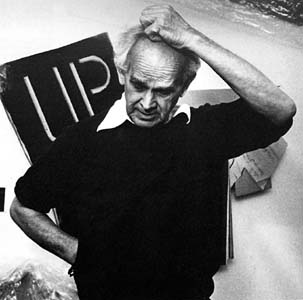
Although I knew he was also a painter, the Manny Farber I first encountered in back issues of Film Culture and in collected writings like Negative Space (1971) was a brilliant, spirited, clear-eyed, iconoclastic, no-nonsense film critic. Essays like "White Elephant Art vs. Termite Art" (1962) were lean, mean, superbly on target and amazingly prescient, celebrating B-films and maverick, marginal auteurs long before they became de rigueur among cineastes. He was an early champion of Howard Hawks, Preston Sturges, Val Lewton and Don Siegel, and penned some of the first American appreciations of Rainer Werner Fassbinder, Marguerite Duras, Werner Herzog, Chantal Akerman and other 70s European avantgardists.
His commitment to genre and grit, to economies of scale and purpose, to the joys of pulp and a contrarian, underground aesthetic, were legendary. His prose was pugilistic, hardboiled and decidedly interdisciplinary, setting an example for future cultural critics. He employed references from all over the spectrum, drawing from abstract expressionist painting, comics, photography, performance art, and from a wide ranging connoisseurship of tasty vernacular forms. He was less literary than visual, less concerned with polite plot elements than viscerally engaged in the mise en scene. His best writing seems to come from within the film, not as a critic judging from on high but rather as a fellow artist, intuitively solving problems and thinking on his feet along with the director.
Farber eloquently and mercilessly excoriated the bloated, mindless excesses of "good taste", the hypocrisy and creative pretensions perpetuated by the Hollywood studio system. He was a staunch foe of lazy, acquiescent thinking, of the prosaic and the middlebrow. He did not suffer fools gladly. In support of his "small, mobile, intelligent" strategy, he reveled in language that was dense, rhythmic, pungent and precise as a jewel cutter.

Farber contributed reviews and essays to The New Republic, Time, The Nation, Film Comment, and Artforum, as well as to second tier stroke mags like Cavalier. Starting in the mid 70s, he was professor at the University of California San Diego, and regularly exhibited his work. A retrospective show of paintings, entitled About Face, opened at PS 1 in New York in September 2004 after previously being presented at the Museum of Contemporary Art San Diego and the Austin Museum of Art in Texas.
Farber began as an abstract painter but settled on figuration in his mature work, to become a master of the idiosyncratic still life. The painting below, Howard Hawks "A Dandy's Gesture" (1978), is part of the "Auteur Series" (there are also pieces named for Anthony Mann and Luis Bunuel). It employs a scattershot arrangement of objects and notepad drawings (elephant, airplane, speedboat, railroad tracks, cattle, houses, chocolate candies), presented out of scale and seemingly viewed from above, as if they are miniatures on a worktable or maquettes from a set designer, a collection of decontextualized signifiers recalling some of the director's most famous efforts: To Have and Have Not, Twentieth Century, Hatari!, Red River.

Like Robert Frank and Larry Rivers, Farber was the quintessential Jewish hipster, effortlessly inventive and subversive, an inveterately wisecracking wordsmith, a kibbitzer, an elder statesman of the counterculture. Susan Sontag once said, “Manny Farber is the liveliest, smartest, most original film critic this country has ever produced … [his] mind and eye change the way you see.”
He passed away in his sleep on Sunday, August 17, 2008, at the age of 91. As obituaries appear online, they will be linked below.

Obits, Memorials, Appreciations
Village Voice: J. Hoberman
NY Times
Green Cine
Movie City Indie
Glenn Kenny
Vanity Fair: James Wolcott
Artforum.com
EW.com
Vinyl Is Heavy
SpoutBlog
Variety
Jim Emerson
Aint It Cool News
G Spot
Defamer
San Diego Reader (2006)
Girish (2006)
Framework (1999), with great bibliography